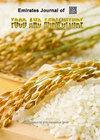不同种植密度和喷虫方式下豇豆病毒病的发病率和严重程度
IF 0.7
4区 农林科学
Q3 AGRONOMY
引用次数: 0
摘要
病毒性疾病是尼日利亚豇豆生产的一个主要问题,导致产量下降高达100%。为了解决这个问题,农民使用杀虫剂喷洒和控制植物种群密度。在2016年种植季,在尼日利亚南几内亚大草原农业生态区进行了田间试验,评估了种植密度和杀虫剂喷洒制度对豇豆病毒病的影响。研究发现,密度为25×75 cm时发病率最低(32.2%),密度为75×75 cm时发病率最高(41.9%)。密度为25×7 5cm时,3种喷药方案的发病率最低,为18.6%;密度为75×75 5cm时,未喷药方案的发病率最高,为66.5%。因此,建议种植密度为25×75厘米,使用三种杀虫喷雾。本研究强调了种植密度和杀虫喷雾制度对豇豆生产中病毒性病害管理的重要性。农民可以利用这些信息来减少疾病的发病率和严重程度,并提高产量。本文章由计算机程序翻译,如有差异,请以英文原文为准。
Incidence and Severity of Virus Diseases of Cowpea (Vigna unguiculata L. Walp) Under Varying Planting Density and Insecticidal Spray Regimes
Viral diseases are a major problem for cowpea production in Nigeria, causing yield reductions of up to 100%. To combat this, farmers use insecticide sprays and manipulate plant population densities. A field experiment was conducted in the Southern Guinea Savannah agro-ecological zone of Nigeria in 2016 cropping season to assess the impact of planting density and insecticidal spray regimes on virus diseases in cowpea. The study found that the lowest disease incidence (32.2%) was observed at a density of 25×75 cm, and the highest (41.9%) at a density of 75×75 cm. The combination of a density of 25×7 5cm with three insecticidal spray regimes had the lowest incidence (18.6%), while 75×75 cm with no insecticidal spray had the highest (66.5%) disease incidence. Thus, it is recommended to use a planting density of 25×75 cm with three insecticidal spray regimes. This study emphasizes the importance of planting density and insecticidal spray regimes in managing viral diseases in cowpea production. Farmers can utilize this information to reduce disease incidence and severity and increase yield.
求助全文
通过发布文献求助,成功后即可免费获取论文全文。
去求助
来源期刊

Emirates Journal of Food and Agriculture
AGRONOMYFOOD SCIENCE & TECHNOLOGY&nb-FOOD SCIENCE & TECHNOLOGY
CiteScore
1.80
自引率
0.00%
发文量
18
期刊介绍:
The "Emirates Journal of Food and Agriculture [EJFA]" is a unique, peer-reviewed Journal of Food and Agriculture publishing basic and applied research articles in the field of agricultural and food sciences by the College of Food and Agriculture, United Arab Emirates University, United Arab Emirates.
 求助内容:
求助内容: 应助结果提醒方式:
应助结果提醒方式:


